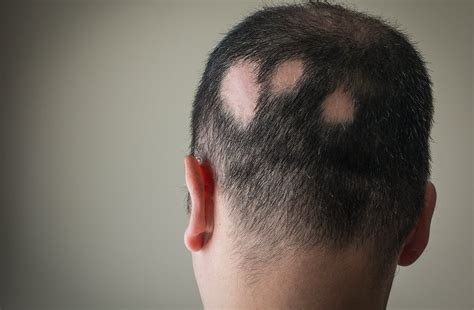What is a Bald Head Patch?
A bald head patch, also known as alopecia areata, is a common autoimmune disorder that causes hair loss in patches. It can affect people of all ages, races, and ethnicities. Bald head patches usually develop suddenly and can range in size from small, round spots to large, irregular patches.

Causes of Bald Head Patches
The exact cause of bald head patches is unknown, but it is thought to be related to an autoimmune disorder. In people with bald head patches, the immune system mistakenly attacks the hair follicles, causing them to stop producing hair.
Risk Factors for Bald Head Patches
Certain factors may increase the risk of developing bald head patches, including:
- Family history: People with a family history of bald head patches are more likely to develop the condition.
- Age: Bald head patches can occur at any age, but they are most common in people between the ages of 20 and 40.
- Sex: Women are more likely to develop bald head patches than men.
- Certain medical conditions: People with certain medical conditions, such as thyroid disease, diabetes, and lupus, are more likely to develop bald head patches.
- Medications: Certain medications, such as chemotherapy and blood thinners, can cause bald head patches.
Symptoms of Bald Head Patches
The main symptom of bald head patches is the sudden development of one or more round or irregular patches of hair loss. The patches can vary in size, from small spots to large areas. The hair loss is usually smooth and round, and the skin underneath the patch may be slightly red or inflamed.
Diagnosis of Bald Head Patches
A doctor can usually diagnose bald head patches by examining the scalp and asking about the person’s medical history. In some cases, a doctor may order a biopsy to confirm the diagnosis.
Treatment for Bald Head Patches
There is no cure for bald head patches, but there are treatments that can help to slow or stop hair loss and promote hair regrowth. Treatments include:
- Topical medications: Topical medications, such as minoxidil and corticosteroids, can be applied to the scalp to help slow hair loss and promote hair regrowth.
- Oral medications: Oral medications, such as finasteride and dutasteride, can be taken to help slow hair loss.
- Light therapy: Light therapy involves exposing the scalp to ultraviolet light to help stimulate hair growth.
- Surgery: Surgery may be an option for people with large or persistent bald head patches.
Prevention of Bald Head Patches
There is no sure way to prevent bald head patches, but there are some things that may help to reduce the risk of developing the condition, including:
- Managing stress: Stress can trigger bald head patches in some people. Finding ways to manage stress, such as exercise, yoga, or meditation, may help to reduce the risk of developing the condition.
- Avoiding hair products that irritate the scalp: Some hair products, such as dyes and styling products, can irritate the scalp and trigger bald head patches. Avoiding these products may help to reduce the risk of developing the condition.
Cure for Bald Head Patches
There is currently no cure for bald head patches, but research is ongoing to find new treatments that can help to slow or stop hair loss and promote hair regrowth.
Common Mistakes to Avoid
There are a few common mistakes that people with bald head patches should avoid, including:
- Over-treating: Over-treating bald head patches can actually make the condition worse. It is important to follow the doctor’s instructions carefully and not to use more medication than prescribed.
- Scratching or picking at the patches: Scratching or picking at the patches can damage the hair follicles and make the condition worse. It is important to avoid touching the patches and to keep them clean.
Conclusion
Bald head patches are a common autoimmune disorder that can cause hair loss in patches. The exact cause of bald head patches is unknown, but it is thought to be related to an autoimmune disorder. There is no cure for bald head patches, but there are treatments that can help to slow or stop hair loss and promote hair regrowth. It is important to follow the doctor’s instructions carefully and to avoid over-treating the condition.
